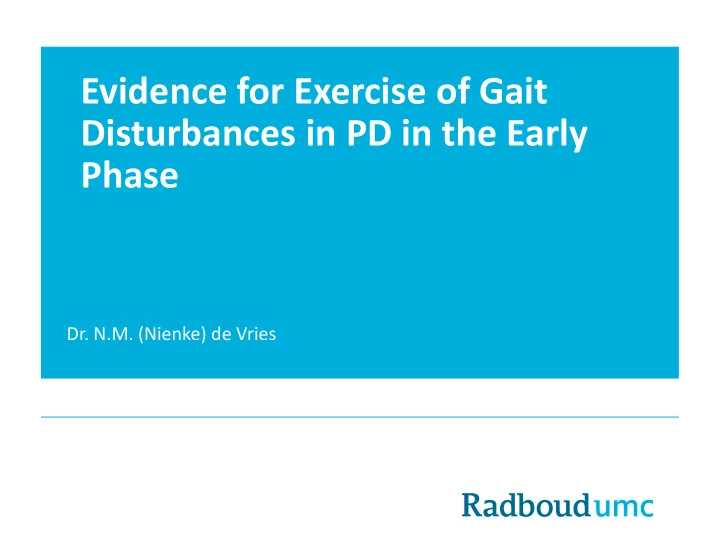

Evidence for Exercise of Gait Disturbances in PD in the Early Phase Dr. N.M. (Nienke) de Vries
Inactivity AND Parkinson’s disease Cardiovascular disease Osteoporosis Insomnia Cognitive decline Depression Constipation All cause mortality
Positive effects of exercise Reasons for prescribing exercise Generic health benefits GAIT Specific additional benefits in PD Disease-modifying effects ??
Starting point
Exercise Action obser- Strategies vation Motor Treadmill imagery Dual task Dance training Martial Nordic Walking arts Exer- Water based gaming
Efficacy on outcomes per type of intervention Motor Symptoms Balance outcomes Gait outcomes Quality of Life outcomes (MDS-) UPDRS TUG BBS 6MWT 10MWT Gait speed Stride Length Cadence PDQ-39 Conventional 0.48 [0.35, 0.60]** 0.11 [-0.07, 0.29] 0.03 [-0.25, 0.31] 0.13 [-0.01, 0.28] 0.30 [0.01, 0.59] 0.24 [0.03, 0.45] 0.28 [-0.11, 0.67] 0.52 [0.11, 0.92] 0.11 [0.01, 0.22] PT (n=45) n=26 n=14 n=3 n=6 n=6** n=11 n=4 n=4** n=17* Resistance 0.20 [-0.02, 0.42] 0.19 [-0.05, 0.43] 0.31 [-0.47, 1.09] 0.67 [0.09, 1.24] -0.07[-0.30, 0.16] -0.63 [-1.20, -0.06] 0.23 [0.01, 0.43] training n=7 n=6 n=1 n=2* n=6 n=2 n=7 (n=17) Treadmill 0.10 [-0.09, 0.29] 0.07 [-0.19, 0.34] 0.21 [-0.13, 0.55] 0.29 [0.04, 0.55]* 0.47 [0.08, 0.85] 0.52 [0.34, 0.69] 0.20 [-0.04, 0.44] 0.12 [-0.15, 0.39] -0.06 [-0.49, training n=16 n=8 n=5 n=9 n=4* n=23** n=12 n=9 0.36] (n=32) n=4 Strategy 0.43 [-0.32, 1.18] 0.53 [0.23, 0.82] 0.12 [-0.43, 0.68] -0.02 [-0.90, 0.85] -0.04 [-0.60, 0.51] 0.45 [0.13, 0.76] 0.52 [0.11, 0.93] 0.47 [-0.01, 0.95] 0.17 [-0.34, training n=1 n=6** n=1 n=1 n=1 n=6** n=4 n=3 0.67] (n=14) n=2 Dance (n=11) 0.72 [0.44, 1.01] 0.49 [0.19, 0.80] 0.59 [0.27, 0.91] 0.51 [0.10, 0.91] 0.32 [-0.02, 0.66] 0.11 [-0.36, 0.58] 1.33 [0.31, 2.34] -0.13 [-0.63, n=8** n=8** n=7** n=4* n=6 n=3 n=1* 0.38] n=3
Tango
Efficacy on outcomes per type of intervention Motor Balance outcomes Gait outcomes Quality of Life Symptoms outcomes (MDS-) UPDRS TUG BBS 6MWT 10MWT Gait speed Stride Length Cadence PDQ-39 Martial arts 0.26 [0.08, 0.43] 0.56 [0.36, 0.77] 0.24 [-0.02, 0.49] 0.20 [-0.15, 0.55] 0.29 [0.07, 0.52] 0.32 [0.07, 0.56] -0.09 [-0.66, 0.47] (n=11) n=10* n=7** n=4 n=3 n=6* n=3* n=2 Nordic walking 0.74 [0.24, 1.24] 0.55 [0.06, 1.04] 0.99 [0.48, 1.50] 0.94 [0.28, 1.60] 0.37 [-0.15, 0.90] 0.46 [-0.18, 1.11] (n=3) n=3** n=3* n=3** n=2* n=2 n=1 Aerobic 0.92 [0.61, 1.22] 0.80 [0.44, 1.15] 1.02 [0.69, 1.34] 0.20 [-0.11, 0.52] exercises (n=5) n=4** n=1** n=3** n=2 Balance and 0.34 [0.11, 0.56] 0.36 [0.15, 0.58] 0.57 [0.35, 0.79] -0.12 [-0.48, 0.23] 0.15 [-0.56, 0.85] 0.28 [0.12, 0.44] 0.36 [0.12, 0.59] 0.24 [-0.01, 0.48] 0.28 [-0.04, 0.60] gait training n=12* n=11** n=12** n=4 n=2 n=17** n=10* n=8 n=6 (n=28)
30-45 min/session, 3/week, 6 months
‘ Remote control from Nijmegen Patient’s home Upload: new individual Download: real time & post training schemes hoc training output Radboud University Nijmegen
Signing up is not enough!
Delta UPDRS III (in OFF phase) Difference 4.2 points (95% CI: 1.6 – 6.9); p=0.002 Aerobic intervention Active control
Delta VO2max (ml/kg/min) Difference 4.2 points (95% CI: 1.6 – 6.9) p < 0.001 Aerobic intervention Active control
Effect of Aerobic Exercise
Efficacy on outcomes per type of intervention Motor Symptoms Balance outcomes Gait outcomes Quality of Life outcomes (MDS-) UPDRS TUG BBS 6MWT 10MWT Gait speed Stride Length Cadence PDQ-39 Hydrotherapy -0.11 [-0.41, 0.19] 0.50 [0.25, 0.75] 0.31 [0.04, 0.59] 0.39 [-0.01, 0.79] (n=8) n=5 n=8** n=7 n=3 Dual task -0.18 [-0.79, 0.42] -0.36 [-1.39, 0.66] -0.25 [-0.85, 0.34] -0.08 [-0.46, 0.30] -0.29 [-0.65, 0.07] -0.04 [-0.78, 0.71] (n=3) n=2 n=1 n=2 n=1 n=2 n=1 Exergaming 0.58 [0.29, 0.87] 0.47 [0.17, 0.77] 0.23 [-0.20, 0.67] -1.66 [-2.84,-0.48] 0.30 [-0.02, 0.62] 0.77 [-0.07, 1.60] 0.45 [0.13, 0.77] (n=9) n=7** n=6* n=3 n=1* n=4 n=1 n=4*
Conclusion A total of 191 trials with 7998 participants were included. Main conclusions: • Conventional physiotherapy significantly improved motor symptoms, gait, and quality of life. • Resistance training improved gait. • Treadmill training improved gait. • Strategy training improved balance and gait. • Dance improved motor symptoms, balance and gait • Nordic walking improved motor symptoms, balance and gait • Balance and gait training improved motor symptoms, balance and gait • Martial arts improved motor symptoms, balance, and gait. • Exergaming improved balance, quality of life and gait. • Hydrotherapy improved balance. • Dual task training did not significantly improve any of the outcomes.
How to select a gait intervention? Which gait Are there related personal problem? factors or prefereces? Evidence In which context?
Barriers and Motivators
Barriers and Motivators • Barriers related to PD • Ability to integrate exercise in daily life • Personal factors • Environmental factors • Role of medical specialists
Future perspectives
Take home message in PD ❑ Different types of exercise are effective to improve gait outcomes ❑ Adapt to personal preferences ❑ Coach to find ways, materials, places etc ❑ Follow-up and use remote technology if needed and when possible ❑ Try to include social support ❑ Choose someting fun!
Thank you! nienke.devries@radboudumc.nl
Recommend
More recommend